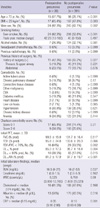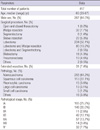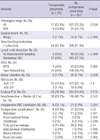1. Parkin DM, Bray F, Ferlay J, Pisani P. Global cancer statistics, 2002. CA Cancer J Clin. 2005. 55:74–108.
2. Busch E, Verazin G, Antkowiak JG, Driscoll D, Takita H. Pulmonary complications in patients undergoing thoracotomy for lung carcinoma. Chest. 1994. 105:760–766.
3. Algar FJ, Alvarez A, Salvatierra A, Baamonde C, Aranda JL, López-Pujol FJ. Predicting pulmonary complications after pneumonectomy for lung cancer. Eur J Cardiothorac Surg. 2003. 23:201–208.
4. Schussler O, Alifano M, Dermine H, Strano S, Casetta A, Sepulveda S, Chafik A, Coignard S, Rabbat A, Regnard JF. Postoperative pneumonia after major lung resection. Am J Respir Crit Care Med. 2006. 173:1161–1169.
5. Belda J, Cavalcanti M, Ferrer M, Serra M, Puig de la Bellacasa J, Canalis E, Torres A. Bronchial colonization and postoperative respiratory infections in patients undergoing lung cancer surgery. Chest. 2005. 128:1571–1579.
6. Shiono S, Yoshida J, Nishimura M, Hagiwara M, Hishida T, Nitadori J, Nagai K. Risk factors of postoperative respiratory infections in lung cancer surgery. J Thorac Oncol. 2007. 2:34–38.
7. Arozullah AM, Khuri SF, Henderson WG, Daley J. Development and validation of a multifactorial risk index for predicting postoperative pneumonia after major noncardiac surgery. Ann Intern Med. 2001. 135:847–857.
8. Garner JS, Jarvis WR, Emori TG, Horan TC, Hughes JM. CDC definitions for nosocomial infections, 1988. Am J Infect Control. 1988. 16:128–140.
9. Stéphan F, Boucheseiche S, Hollande J, Flahault A, Cheffi A, Bazelly B, Bonnet F. Pulmonary complications following lung resection: a comprehensive analysis of incidence and possible risk factors. Chest. 2000. 118:1263–1270.
10. Charlson ME, Pompei P, Ales KL, MacKenzie CR. A new method of classifying prognostic comorbidity in longitudinal studies: development and validation. J Chronic Dis. 1987. 40:373–383.
11. Yamada Y, Sekine Y, Suzuki H, Iwata T, Chiyo M, Nakajima T, Yasufuku K, Yoshida S. Trends of bacterial colonisation and the risk of postoperative pneumonia in lung cancer patients with chronic obstructive pulmonary disease. Eur J Cardiothorac Surg. 2010. 37:752–757.
12. Nagasaki F, Flehinger BJ, Martini N. Complications of surgery in the treatment of carcinoma of the lung. Chest. 1982. 82:25–29.
13. Tartter PI, Quintero S, Barron DM. Perioperative blood transfusion associated with infectious complications after colorectal cancer operations. Am J Surg. 1986. 152:479–482.
14. Tartter PI. Blood transfusion and infectious complications following colorectal cancer surgery. Br J Surg. 1988. 75:789–792.
15. Roth JA, Golub SH, Grimm EA, Eilber FR, Morton DL. Effects of operation on immune response in cancer patients: sequential evaluation of in vitro lymphocyte function. Surgery. 1976. 79:46–51.
16. Waymack JP, Gugliuzza K, Dong YL, Herndon DN. Effect of blood transfusion on immune function. IX. Effect on lymphocyte metabolism. J Surg Res. 1993. 55:269–272.
17. Jensen LS, Andersen AJ, Christiansen PM, Hokland P, Juhl CO, Madsen G, Mortensen J, Møller-Nielsen C, Hanberg-Sørensen F, Hokland M. Postoperative infection and natural killer cell function following blood transfusion in patients undergoing elective colorectal surgery. Br J Surg. 1992. 79:513–516.
18. MacLean LD, Meakins JL, Taguchi K, Duignan JP, Dhillon KS, Gordon J. Host resistance in sepsis and trauma. Ann Surg. 1975. 182:207–217.
19. Kaplan J, Sarnaik S, Gitlin J, Lusher J. Diminished helper/suppressor lymphocyte ratios and natural killer activity in recipients of repeated blood transfusions. Blood. 1984. 64:308–310.
20. Iwamoto K, Ichiyama S, Shimokata K, Nakashima N. Postoperative pneumonia in elderly patients: incidence and mortality in comparison with younger patients. Intern Med. 1993. 32:274–277.
21. Wong DH, Weber EC, Schell MJ, Wong AB, Anderson CT, Barker SJ. Factors associated with postoperative pulmonary complications in patients with severe chronic obstructive pulmonary disease. Anesth Analg. 1995. 80:276–284.
22. Smetana GW. Preoperative pulmonary evaluation. N Engl J Med. 1999. 340:937–944.
23. Antimicrobial prophylaxis for surgery. Treat Guidel Med Lett. 2009. 7:47–52.
24. Edwards FH, Engelman RM, Houck P, Shahian DM, Bridges CR. The Society of Thoracic Surgeons practice guideline series: antibiotic prophylaxis in cardiac surgery. Part I: duration. Ann Thorac Surg. 2006. 81:397–404.
25. Engelman R, Shahian D, Shemin R, Guy TS, Bratzler D, Edwards F, Jacobs M, Fernando H, Bridges C. The Society of Thoracic Surgeons practice guideline series: antibiotic prophylaxis in cardiac surgery. Part II: antibiotic choice. Ann Thorac Surg. 2007. 83:1569–1576.
26. Aznar R, Mateu M, Miró JM, Gatell JM, Gimferrer JM, Aznar E, Mallolas J, Soriano E, Sanchez-Lloret J. Antibiotic prophylaxis in non-cardiac thoracic surgery: cefazolin versus placebo. Eur J Cardiothorac Surg. 1991. 5:515–518.
27. Ioanas M, Angrill J, Baldo X, Arancibia F, Gonzalez J, Bauer T, Canalis E, Torres A. Bronchial bacterial colonization in patients with resectable lung carcinoma. Eur Respir J. 2002. 19:326–332.






 PDF
PDF ePub
ePub Citation
Citation Print
Print






 XML Download
XML Download